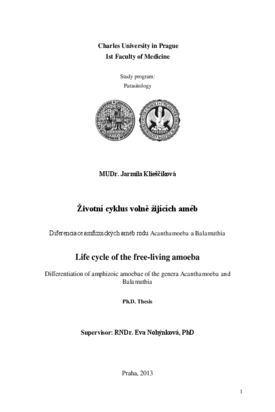Live cycle of the free-living amoeba. Differentiation of amoebae of the genera Acanthamoeba and Balamuthia
Životní cyklus volně žijících améb. Diferenciace amfizoických améb rodu Acanthamoeba a Balamuthia
dizertační práce (OBHÁJENO)

Zobrazit/
Trvalý odkaz
http://hdl.handle.net/20.500.11956/52889Identifikátory
SIS: 85893
Katalog UK: 990016054600106986
Kolekce
- Kvalifikační práce [4870]
Autor
Vedoucí práce
Oponent práce
Ondriska, František
Walochnik, Julia
Fakulta / součást
1. lékařská fakulta
Obor
-
Katedra / ústav / klinika
Klinika infekčních a tropických nemocí 1. LF UK v Praze a Nemocnice Na Bulovce
Datum obhajoby
17. 6. 2013
Nakladatel
Univerzita Karlova, 1. lékařská fakultaJazyk
Angličtina
Známka
Prospěl/a
Klíčová slova (česky)
Acanthamoeba spp, Balamuthia mandrillaris, diferenciace, encystace, cysta, pseudocysta, celulóza, lichenin, beta-manan, složeníKlíčová slova (anglicky)
Acanthamoeba spp, Balamuthia mandrillaris, differentiation, encystation, cyst, pseudocyst, cellulose, lichenin, beta-mannan, compositionVolně žijící améby Acanthamoeba spp. a Balamuthia mandrillaris jsou původci závažných onemocnění člověka: vzácné, většinou fatální granulomatózní amébové encefalitidy (obě) nebo keratitidy (akantaméby). Jedním z důvodů neúspěšné terapie je schopnost trofozoitů obou organizmů vytvářet rezistentní stádia - cysty, které lze najít také v postižených tkáních. V naší práci jsme zjistili, že encystace u akantaméb vyžaduje kromě jiného přítomnost fungujícího Golgiho aparátu, který se podílí na trasportu materiálu pro stavbu cystové stěny na povrch buňky; glykogenfosforylázy, enzymu, který degraduje glykogen na podjednotky glukózy využívané encystující buňkou pro syntézu celulózy a dvě nově exprimované celulóza syntázy. Syntéza celulózy u akantaméb není inhibovaná známými herbicidy. Kromě celulózy jsme v cystové stěně akantaméb detekovali -mannan a -1,3-1,4-glukan (lichenin). Zatímco celulóza je přítomna ve vnitřní (endocystě) a zevní stěně (exocystě) cysty, -mannan a lichenin se nacházejí pouze v endocystě. Lichenin, který byl u protozoí v naší studii detekován vůbec poprvé, má podobnou stavbu jako lichenin ječmene. Je tvořen především celobiózou a celotriózou s menším podílem celotetrózy. Použitím stejných metod jako u akantaméb se nám nepodařilo detekovat žádný cukerný zbytek v cystové stěně...
Free-living pathogenic amoebae Acanthamoeba spp. and Balamuthia mandrillaris are causative agents of important diseases of human: rarely occurring but highly fatal granulomatous amoebic encephalitis (both) and keratitis (Acanthamoeba). One of the reasons for the problematic therapy is differentiation into highly resistant cysts often found in affected tissues. In our study we have found that correct encystation in Acanthamoeba requires apart from others, the presence of functioning Golgi apparatus transporting the cyst wall material to the cell surface; glycogen phosphorylase degrading glycogen into glucose which seems to be further used for cellulose synthesis and two non-constitutive cellulose synthases. Acanthamoeba cellulose synthases seem not to be inhibited by known herbicides. In the cyst wall of acanthamoebae we detected cellulose, -mannan, and -1, 3-1, 4-linked glucan [lichenin or mixed-linkage glucan (MLG)]. Cellulose is present in the inner (endocyst) and the outer (exocyst) layers of the cyst wall, whereas-mannan and MLG are found in the endocyst. In a protozoan organism, MLG was detected for the first time. The MLG of Acanthamoeba has a similar composition to that found in barley with high amount of cellobiosyl and cellotriosyl followed by cellotetraosyl units. In contrast, with...
